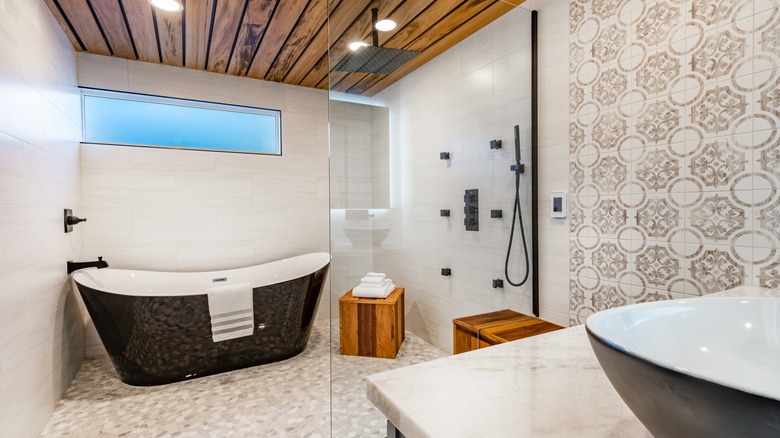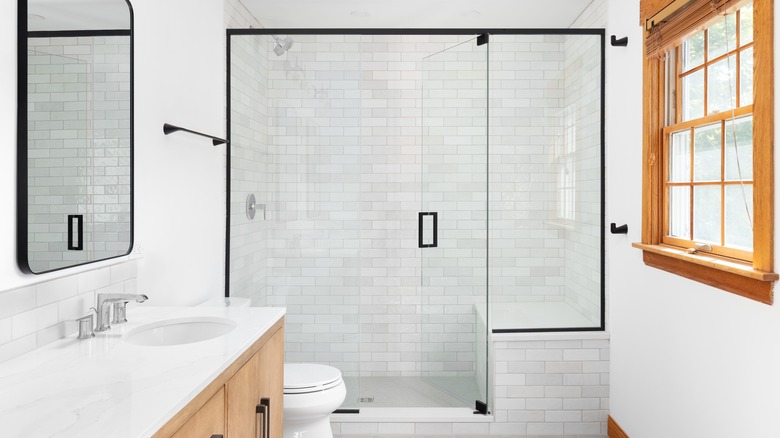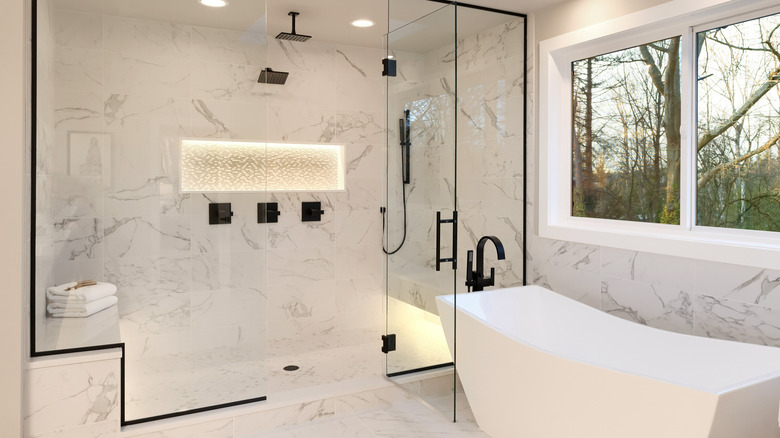Here's Where You Should Place Your Shower Bench
When it comes to shower design, one element that often gets overlooked is the shower bench. One primary purpose of a shower bench is to enhance the functionality and safety of your shower. So these factors should be top of mind when deciding where to place it, and it should be in a spot that allows easy access without hindering movement within the shower area. That being said, the placement of a shower bench is a critical consideration, and your best bet is right across from the shower head.
Another popular placement for a simple shower bench is the back wall of the shower, away from the showerhead. This works well in rectangular showers, where placing the bench along the shorter back wall utilizes space effectively.
While functionality and safety are important, your bench should blend in with the bathroom's overall design and the available space. This seemingly simple addition can add a touch of luxury and convenience to your shower experience, not to mention providing essential support if you have mobility issues. The best time to install a built-in shower seat is during construction or renovation. If you're constructing the bench as part of a renovation or new building project, consult your builder or designer to ensure it's comfortable and strong enough to sustain an adult's weight.
We'll now detail the key elements you should consider and the factors for improving your shower's comfort and accessibility while keeping it fashionable and well-designed.
Try to balance accessibility, safety, and comfort
Suppose your goal is to improve accessibility in your shower. In that case, you may consider selecting a design that adheres to the Americans with Disabilities Act (ADA) standards. The ADA-compliant designs follow specific height, size, and support criteria to accommodate individuals with disabilities. In a shower setup where you have to move from a wheelchair to the shower bench — specifically one with dimensions of 36 inches on each side — it's crucial to properly position all shower elements, such as the valve and faucet. You should place them within reach on the wall directly across from the seat. Their height should also be strategically set within a vertical range of no less than 38 inches but shouldn't be more than 48 inches from the floor.
Incorporating a built-in bench into your walk-in shower also helps enhance both comfort and safety during your bathing routine. This thoughtful addition allows you to take a moment to relax and enjoy the tranquility of the shower while significantly reducing the chances of accidental slips or falls. You also have to think about the safety of the shower tile. Ceramic tile is popular for shower tiles due to its durability, versatility, and wide range of style options. Choosing non-slip ceramic tiles for your shower floor is wise, given the slippery nature of wet surfaces.
Shower seat for relaxation or aesthetics
If you're after a design for relaxation purposes and have enough space, a deep shower seat is best. A deep, rectangular shower seat can significantly enhance the relaxation aspect of your showering experience. It allows you to sit comfortably and lie back, turning your daily shower into a spa-like experience. As always, the bench should be made from water-resistant materials — you might want to opt for marble, which has a timeless elegance and natural beauty. It can instantly elevate the appearance of your bathroom, giving it a luxurious, spa-like ambiance.
If you're after a minimalist design, remember that simplicity is key. A minimal shower bench with a niche of the same width can give your bathroom a sleek and clean look, promoting harmony and balance.
For smaller shower spaces, corner benches are another space-efficient option that doesn't compromise comfort or aesthetics. For aesthetic purposes, you can design a corner bench with a curved format with all controls placed on one wall and within easy reach. Other clever solutions include bringing in a garden bench or incorporating an L-shaped design.


